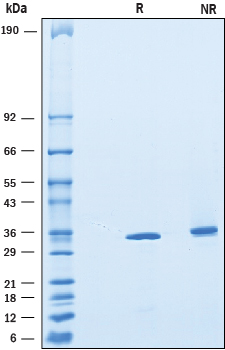Recombinant Mouse CTRP4/C1qTNF4 His-tag Protein, CF Summary
Product Specifications
Leu17-Leu326, with a C-terminal 6-His tag
Analysis
Product Datasheets
Carrier Free
CF stands for Carrier Free (CF). We typically add Bovine Serum Albumin (BSA) as a carrier protein to our recombinant proteins. Adding a carrier protein enhances protein stability, increases shelf-life, and allows the recombinant protein to be stored at a more dilute concentration. The carrier free version does not contain BSA.
In general, we advise purchasing the recombinant protein with BSA for use in cell or tissue culture, or as an ELISA standard. In contrast, the carrier free protein is recommended for applications, in which the presence of BSA could interfere.
2137-TN
| Formulation | Lyophilized from a 0.2 μm filtered solution in HEPES and NaCl with Trehalose. |
| Reconstitution | Reconstitute at 500 μg/mL in water. |
| Shipping | The product is shipped at ambient temperature. Upon receipt, store it immediately at the temperature recommended below. |
| Stability & Storage: | Use a manual defrost freezer and avoid repeated freeze-thaw cycles.
|
Scientific Data
 View Larger
View Larger
2 μg/lane of Recombinant Mouse CTRP4/C1qTNF4 was resolved with SDS-PAGE under reducing (R) and non-reducing (NR) conditions and visualized by Coomassie® Blue staining, showing bands at 34-38 kDa.
Reconstitution Calculator
Background: CTRP4/C1qTNF4
C1qTNF4, also known as CTRP4, is an approximately 34 kDa member of the C1q family of secreted proteins (1, 2). C1qTNF4 consists of a signal peptide followed by two tandem globular C1q domains (1). It is the only C1q family member with tandem C1q domains (1, 2). The second C1q domain contains an RGD peptide, suggesting that it could potentially interact with integrins (3). Mature mouse C1qTNF4 shares 95% and 98% amino acid sequence identity with human and rat C1qTNF4, respectively. Expression of human C1qTNF4 occurs most abundantly in brain and adipose tissue (1). Neurons in the hypothalamus express and secrete CTRP4 which modulates food intake and energy balance by controlling neuropeptide gene expression (1). In-house finding shows CTRP4 can support neurite outgrowth of cortical neurons. Like other CTRP family members, C1qTNF4 can form dimers, trimers, hexamers, and high molecular weight oligomers following secretion (1, 4). Injection of recombinant C1qTNF4 into mice can reduce food intake, body weight, and ambulatory activity levels (1). C1qTNF4 has also been shown to promote human cancer cell survival in vitro (5).
- Byerly, M.S. et al. (2014) J. Biol. Chem. 289:4055.
- Kishore, U. et al. (2004) Trends Immunol. 25:551.
- Ruoslahti, E. (1996) Annu. Rev. Cell Dev. Biol. 12:697.
- Wong, G.W. et al. (2008) Biochem. J. 416:161.
- Li, Q. et al. (2011) Cancer Lett. 308:203.
FAQs
No product specific FAQs exist for this product, however you may
View all Proteins and Enzyme FAQsReviews for Recombinant Mouse CTRP4/C1qTNF4 His-tag Protein, CF
There are currently no reviews for this product. Be the first to review Recombinant Mouse CTRP4/C1qTNF4 His-tag Protein, CF and earn rewards!
Have you used Recombinant Mouse CTRP4/C1qTNF4 His-tag Protein, CF?
Submit a review and receive an Amazon gift card.
$25/€18/£15/$25CAN/¥75 Yuan/¥1250 Yen for a review with an image
$10/€7/£6/$10 CAD/¥70 Yuan/¥1110 Yen for a review without an image
